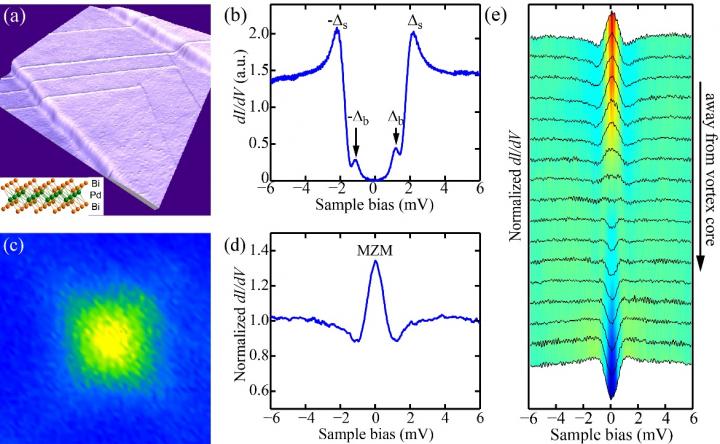Physicists demonstrate topological superconductivity on palladium dibismuthides

Topological superconductivity and Majorana zero modes of epitaxial β-Bi2Pd films by molecular beam epitaxy. (a) Topographic image of β-Bi2Pd films, with the insert as the schematic crystal structure of β-Bi2Pd. (b) Typical differential conductance dI/dV spectrum at 0.4 K, revealing two distinct superconducting gaps from bulk (Δb) and topological surface (Δs) states, respectively. (c) Zero-bias conductance map, showing an individual magnetic vortex (bright yellow region). (d) Tunneling conductance dI/dV spectrum taken at the vortex center, signifying a salient zero bias conductance peak. (e) The dI/dV spectra acquired at positions with varying radial distance r from the vortex center. The peaks shows no splitting and is invariably fixed to the zero energy, anticipated for Majorana zero modes. Credit: ©Science China Press
A topological superconductor is superconducting inside the bulk like usual superconductors, while on the boundary/surface it harbors the long-sought Majorana fermions. Such unusual particles obey non-Abelian braiding statistics and could be potential for fault-tolerant quantum computing, which can operate much more efficiently than any current computers.
A handful of topological superconductors have hitherto been proposed in topological insulators or other systems with strong spin-orbital coupling when they are interfaced with a superconductor or driven into the superconducting states by chemical doping. However, little attention is paid to the other way of thinking, to wit, searching for topologically nontrivial band structure in classical s-wave superconductors.
Tetragonal β-Bi2Pd was found to be superconducting below 5.4 K in 1957. Just recently, it was revealed from angle-resolved photoemission spectroscopy that topologically protected surface bands cross the Fermi level of β-Bi2Pd.
The two major ingredients of realizing topological superconductivity are coincidently existing in this single-component compound. Subsequent experimental search for the buried topological superconductivity in β-Bi2Pd all fell flat. The researchers in Tsinghua University have caught the rare opportunity and unmasked the veil of topologically nontrivial superconducting states in β-Bi2Pd.
“We are motivated to unravel why the topological superconductivity failed to be observed in all previous studies of β-Bi2Pd crystals, it is now known that tuning the chemical potential to isolate the topological surface states from bulk bands near the Fermi level is the key to observe such topologically nontrivial superconducting states,” said Yanfeng Lv, the first author of this study, now is a postdoctoral researcher at Texas Center for Superconductivity, University of Houston.
Published in the journal of Science Bulletin, the study utilized a state-of-the-art molecular beam epitaxy technique under ultrahigh vacuum to prepare successfully high-quality β-Bi2Pd thin films on SrTiO3 substrates, which was then in-situ transferred to a cryogenic scanning tunneling microscopy chamber.
The tunneling spectrum revealed a pronounced and impurity-resistant superconducting gap opening on the surface, which appears much larger than the bulk on owing to Dirac-fermion enhanced parity mixing of surface pair potential. The direct visualization of superconducting gap opening on the topological surface states, as well as its expected variation with the Fermi level, compellingly reveals β-Bi2Pd as a promising candidate for topological superconductor. Salient zero bias conductance peaks, probably from Majorana zero modes supported by such superconducting states, were identified at the end of magnetic vortex lines.
“This research provides the convincing evidence of topological superconductivity on β-Bi2Pd and signature of Majorana zero modes at vortices,” said the researchers, “and more importantly points to a novel avenue for searching topological pairing states on usual superconductors that might exhibit topologically nontrivial band structure by the engineering of Fermi level.”
This work was financially supported by National Science Foundation, Ministry of Science and Technology and Ministry of Education of China, the National Thousand-Young-Talents Program and the Tsinghua University Initiative Scientific Research Program.
See the article:
Yan-Feng Lv, Wen-Lin Wang, Yi-Min Zhang, Hao Ding, Wei Li, Lili Wang, Ke He, Can-Li Song, Xu-Cun Ma, Qi-Kun Xue. Experimental signature of topological superconductivity and Majorana zero modes on β-Bi2Pd thin films. Science Bulletin 2017, 62(12): 852-856. https:/
Media Contact
All latest news from the category: Physics and Astronomy
This area deals with the fundamental laws and building blocks of nature and how they interact, the properties and the behavior of matter, and research into space and time and their structures.
innovations-report provides in-depth reports and articles on subjects such as astrophysics, laser technologies, nuclear, quantum, particle and solid-state physics, nanotechnologies, planetary research and findings (Mars, Venus) and developments related to the Hubble Telescope.
Newest articles

Properties of new materials for microchips
… can now be measured well. Reseachers of Delft University of Technology demonstrated measuring performance properties of ultrathin silicon membranes. Making ever smaller and more powerful chips requires new ultrathin…

Floating solar’s potential
… to support sustainable development by addressing climate, water, and energy goals holistically. A new study published this week in Nature Energy raises the potential for floating solar photovoltaics (FPV)…

Skyrmions move at record speeds
… a step towards the computing of the future. An international research team led by scientists from the CNRS1 has discovered that the magnetic nanobubbles2 known as skyrmions can be…





















